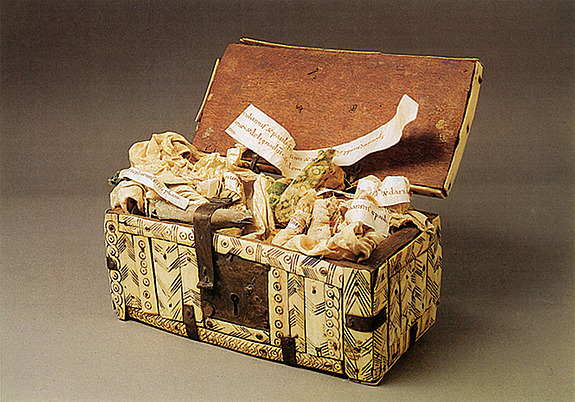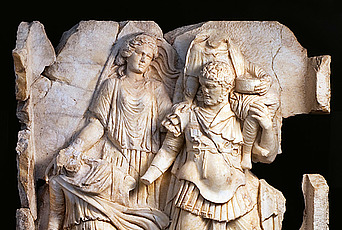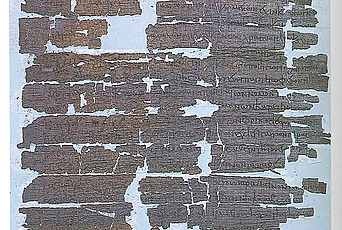Matter for Debate: Relics and Related Devotional Objects

Material objects play a role in all religions. Jewish women light candles for the Sabbath; Christians sprinkle or douse bodies with water to baptize; Hindus offer coconuts and clarified butter to images of the gods and goddesses; the ancient Incas preserved mummies of their ancestors in caves, and Quechua-speaking peoples in the Andes still feel uneasy about these remains. Such objects—coconuts and images, candles and mummies—carry with them a community’s past, making it present and at the same time underlining its location in the past. They convey holiness from place to place, focus prayer and meditation, enforce or undermine hierarchy. But religions do not all venerate or fear the same objects or use them in the same ways. Over the past hundred years, historians of religion have been particularly interested in a subset of devotional objects that have been designated by worshippers with a word that can be translated as “relics” or “remains”: holy bodies or parts of bodies, or physical objects that have been in contact with them or their burial sites. Given this definition, relics are not found in all religions. Jews, for example, do sometimes venerate gravesites (although rabbis have been very dubious about this practice) but they do not revere dead bodies as holy. Hindus return the ashes of the dead to the Ganges rather than preserving them, but Buddhists build monumental containers or stupas for the ashes of the Buddha, and these stupas are considered so powerful that even their shadows convey healing or harm. Moreover, traditions vary over both space and time in how far such objects are crucial. Protestant Christians in the sixteenth century rejected the relic cult of Catholic Christians as superstition or idolatry. So it might seem as if it would be an interesting exercise in comparative religion to explore why some religions have relic cult and some do not. That is what Julia M. H. Smith of the University of Glasgow (see article, page 5) and I thought we were setting out to explore when we began to plan a workshop titled “Matter for Debate: Relics and Related Devotional Objects,” to be held at the Institute in July 2010. But the topic ended up being far more amorphous and far more challenging than that.
Most of the work on “relics” done by scholars in the first two-thirds of the last century took Catholic Christian practice as a paradigm and focused more on what leaders and theologians believed than on what ordinary people did. For example, the famous eleventh edition of the Encyclopedia Britannica (1910–11) dealt only with Christian practices under the rubric “relics,” although the article purported to be general. By the end of the twentieth century, the study of religion had become more genuinely comparative and less Eurocentric. By 1987, the Encyclopedia Britannica had added Buddhist relics to its entry, and Mark Taylor’s 1998 handbook Critical Terms for Religious Studies, which included “relic” as one among the twenty-two most important categories for the study of religion (along with gender, rationality, and experience), assigned the article on relics to a specialist on Buddhism. Influenced by such shifts in scholarly interest, Professor Smith and I decided to organize a workshop that would not be dominated by Christian categories and examples. We also decided to concentrate on what people actually revered and what they did when they reverenced objects, not on what theologians said the objects meant. So we asked fourteen scholars who worked on European Christianity, Buddhism in a variety of Asian locales, Islam, the Andes, and West Africa—all areas and traditions in which there seemed to be something like “relic cult”—to come together and each present a specific object that might not so much answer as sharpen the question “what is a relic?” Although the participants learned much from our three days of conversation, it will not surprise anyone used to academic gatherings to hear that we ended up far less certain than before how to define “relic,” or that we began to doubt whether there is a clear difference between religious traditions with relics and those without.
A quick look at a few of the cases presented by our participants makes this ambiguity clear. Cynthia Hahn of Hunter College discussed the thirteenth-century reliquary of St. Nicholas from Halberstadt, Germany, which displays a mummified finger through a crystal window in a golden arm-shaped container and was used to bless worshippers; Nancy Khalek of Brown University discussed bones or bone fragments from the head of John the Baptist enshrined in Damascus and later in Aleppo and probably the first corporeal relics revered in Islam; Alisa LaGamma, curator at the Metropolitan Museum in New York, spoke about nineteenth-century reliquaries of the Fang and Kota peoples in the area from southern Cameroon to the Republic of the Congo and emphasized not only the artistic quality of the sculptured heads but also the presence of bodies of significant ancestors in the drums underneath the figures. These cases are clear examples of “relic” as conventionally defined, although each of the presenting scholars stressed the performative and political aspects of these objects more than traditional approaches do. But a number of the cases discussed at our workshop expanded the category of holy remains. David Germano of the University of Virginia spoke about several crystal spheres (called chests or reliquaries) with no visible openings that are understood by adherents to have descended from the sky to honor a contemporary guru and to have contained texts, fingers, and other holy objects. Nicholas Paul from Fordham University (and a 2009–10 Member at IAS) presented a twelfth-century ivory object in the form of the Greek letter tau, which is known only through textual references and which functioned ritually to reinforce and reinterpret social categories and carry aristocratic memory. Robert Sharf from the University of California in Berkeley spoke about four finger bones of the Buddha discovered in 1987 in Shaanxi province, China, which have been artfully and obviously fashioned by human hands. And Suzanne Blier from Harvard University argued that the hole cut into the earth as tomb or receptacle for liquid offerings and found in a number of African sites should be characterized as a relic. Any equation of relic with holy body or that which is in contact with holy body, or with something denominated by a word for “remains” or “left behind thing,” tended to dissolve as we explored the cases presented.

Nonetheless some common concerns—more methodological than substantive—emerged from our three days together. We tended to agree that whatever exactly relics are, they should be understood as possessing agency as well as meaning—that is, that they act religiously. We also saw such devotional objects as not merely the tool of elites (clerical or political) and the result of consecration by them but as created and deployed by ordinary worshippers and adherents as well. And we agreed that, whatever definition we adopt, relics are not completely private but must have some communal significance. A photograph of my grandmother or her rolling pin, however much they may mean to me, are not relics in the analytical sense we wished to employ (unless my grandmother was, for example, the iconic feminist figure Margaret Mead). Moreover, we became increasingly convinced as we talked that important questions about the display in museums not only of human remains but of all religious objects as well are still unsettled—not just because of the need for sensitivity to the requirements of living traditions but also because the Western tendency to separate sharply museum context from religious context is far from universal. Finally, we came away from our days together convinced of the value of the format we had chosen—a format some had questioned when they received our initial invitation. In putting together our workshop, Professor Smith and I wanted to allow for the truly free-wheeling sort of discussion possible only if talks are not understood to be committed beforehand to publication. And we wanted to employ the format of the ten-minute presentation that has been so successful at IAS in the series After Hours Conversations. Both aspects seem to have succeeded admirably in making our three days of discussion open, collegial, and creative—even paradigm-breaking. We have already heard that some participants will go forward both to publish new ideas and to craft talks considerably longer than ten minutes, empowered by the conversations in our workshop “Matter for Debate.”


